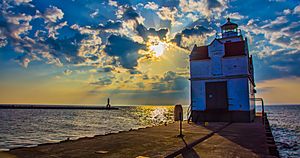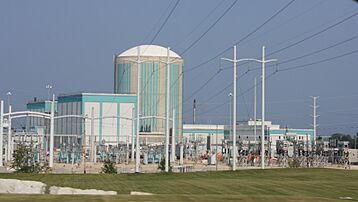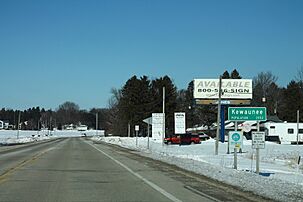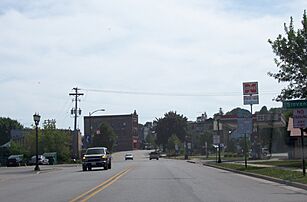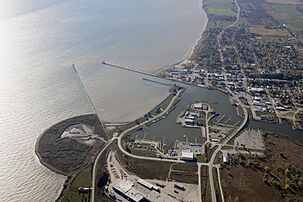Kewaunee, Wisconsin facts for kids
Quick facts for kids
Kewaunee, Wisconsin
|
|
|---|---|
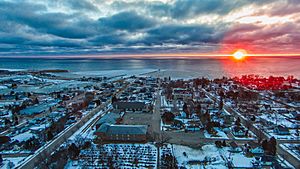
Looking east to the Kewaunee harbor and Lake Michigan
|
|

Location of Kewaunee in Kewaunee County, Wisconsin.
|
|
| Country | |
| State | |
| County | Kewaunee |
| Government | |
| • Type | Municipality |
| Area | |
| • Total | 3.73 sq mi (9.66 km2) |
| • Land | 3.53 sq mi (9.15 km2) |
| • Water | 0.20 sq mi (0.52 km2) |
| Elevation | 610 ft (186 m) |
| Population
(2020)
|
|
| • Total | 2,837 |
| • Density | 803.5/sq mi (310.2/km2) |
| Time zone | UTC-6 (Central (CST)) |
| • Summer (DST) | UTC-5 (CDT) |
| ZIP code |
54216
|
| Area code(s) | 920 |
| FIPS code | 55-39350 |
| GNIS feature ID | 1567445 |
Kewaunee is a city in Kewaunee County, Wisconsin, United States. The population was 2,837 at the 2020 census. Located on the northwestern shore of Lake Michigan, the city is the county seat of Kewaunee County. Its Menominee name is Kewāneh, an archaic name for a species of duck.
Kewaunee is part of the Green Bay Metropolitan Statistical Area.
Contents
History
Kewaunee was the site of a Potawatomi village at the time of European contact in the seventeenth century. French Jesuit missionary Jacques Marquette celebrated All Saints Day at the Potawatomi village in 1674. Later, French explorer René-Robert Cavelier, Sieur de La Salle visited the village in 1679, and Canadian Jesuit Jean-François Buisson de Saint-Cosme stopped in September 1698. The Potawatomis moved south and east along Lake Michigan in the eighteenth century, and the area was reclaimed by Menominee people. Trader Jacques Vieau established a short lived trading post for the North West Company in the area of Kewaunee in 1795. The United States acquired the land from the Menominee nation in the 1831 Treaty of Washington.
The current settlement at Kewaunee began in 1836, when false rumors of gold deposits in the Kewaunee River triggered a minor gold rush of Yankee settlers. Land speculator Joshua Hathaway surveyed and platted the settlement. When no gold was found, the settlers who remained established a sawmill and developed the local harbor for the lumber industry. Kewaunee became the county seat of Kewaunee County at the time of the county's formation in 1852. In the late nineteenth century, the community attracted many Czech and German immigrants.
Geography
Kewaunee is located at 44°27′32″N 87°30′34″W / 44.45889°N 87.50944°W (44.458758, -87.509496).
According to the United States Census Bureau, the city has a total area of 3.73 square miles (9.66 km2), of which, 3.53 square miles (9.14 km2) is land and 0.2 square miles (0.52 km2) is water.
Highways
 WIS 42 Northbound travels to Algoma, Wisconsin. South it continues into Two Rivers and Manitowoc, Wisconsin.
WIS 42 Northbound travels to Algoma, Wisconsin. South it continues into Two Rivers and Manitowoc, Wisconsin. WIS 29 connects with Green Bay, Wisconsin westbound.
WIS 29 connects with Green Bay, Wisconsin westbound.
Demographics
| Historical population | |||
|---|---|---|---|
| Census | Pop. | %± | |
| 1880 | 1,050 | — | |
| 1890 | 1,216 | 15.8% | |
| 1900 | 1,773 | 45.8% | |
| 1910 | 1,839 | 3.7% | |
| 1920 | 1,865 | 1.4% | |
| 1930 | 2,409 | 29.2% | |
| 1940 | 2,533 | 5.1% | |
| 1950 | 2,583 | 2.0% | |
| 1960 | 2,772 | 7.3% | |
| 1970 | 2,901 | 4.7% | |
| 1980 | 2,801 | −3.4% | |
| 1990 | 2,750 | −1.8% | |
| 2000 | 2,806 | 2.0% | |
| 2010 | 2,952 | 5.2% | |
| 2020 | 2,837 | −3.9% | |
| U.S. Decennial Census | |||
2020 census
As of the census of 2020, the population was 2,837. The population density was 803.5 inhabitants per square mile (310.2/km2). There were 1,416 housing units at an average density of 401.0 per square mile (154.8/km2). The racial makeup of the city was 91.5% White, 0.5% Black or African American, 0.5% Asian, 0.5% Native American, 1.9% from other races, and 5.1% from two or more races. Ethnically, the population was 4.2% Hispanic or Latino of any race.
2010 census
As of the census of 2010, there were 2,952 people, 1,278 households, and 733 families living in the city. The population density was 833.9 inhabitants per square mile (322.0/km2). There were 1,462 housing units at an average density of 413.0 per square mile (159.5/km2). The racial makeup of the city was 96.6% White, 0.3% African American, 0.3% Native American, 0.4% Asian, 1.1% from other races, and 1.1% from two or more races. Hispanic or Latino of any race were 1.8% of the population
There were 1,278 households, of which 25.3% had children under the age of 18 living with them, 45.9% were married couples living together, 7.7% had a female householder with no husband present, 3.8% had a male householder with no wife present, and 42.6% were non-families. 36.5% of all households were made up of individuals, and 16.6% had someone living alone who was 65 years of age or older. The average household size was 2.24 and the average family size was 2.81.
The median age in the city was 45.8 years. 19.8% of residents were under the age of 18; 6.7% were between the ages of 18 and 24; 22.4% were from 25 to 44; 28.5% were from 45 to 64; and 22.6% were 65 years of age or older. The gender makeup of the city was 50.4% male and 49.6% female.
Economy
- The Kewaunee Nuclear Generating Station is in Carlton in Kewaunee County. The Kewaunee Power Station was decommissioned on May 7, 2013.
Kewaunee Fabrications is the successor to the Kewaunee Shipbuilding and Engineering, a shipbuilder operating from 1941 to 1945.
Healthcare
Kewaunee is home to two primary care clinics and one urgent care center. The area is in both a mental health and primary care Health Professional Shortage Area (HPSA) qualifying the area as a medical desert. There are 7 primary care providers per 100,000 population in Kewaunee compared to the statewide average of 75.6. By 2035, the area is expected to have a 93.7% deficit in physicians, the largest deficit in Wisconsin. There are no behavior health professionals in Kewaunee.
Attractions
- Kewaunee Pierhead Lighthouse
- Kewaunee Marshland Walk
- Tallest Grandfather Clock
- Tug Ludington
- Ahnapee State Trail
Notable people
- Jerry Augustine, MLB player, head coach of the University of Wisconsin-Milwaukee Panthers baseball team
- Henry Baetz, Treasurer of Wisconsin
- Colin Cochart, NFL player
- Joseph E. Darbellay, Wisconsin State Representative
- Art Fiala, the last surviving World War I veteran from Wisconsin
- George Grimmer, Wisconsin State Senator
- Terry Jorgensen, MLB player
- John C. Karel, Wisconsin State Representative
- L. Albert Karel, Wisconsin State Representative
- Thomas F. Konop, U.S. Representative
- Stan Kuick, NFL player
- Ransom Asa Moore, professor
- Robert E. Minahan, Mayor of Green Bay, Wisconsin
- Jack Novak, NFL player
- Alvin E. O'Konski, U.S. Representative
- John Milton Read, Wisconsin legislator and newspaper editor
- Dena A. Smith, Wisconsin State Treasurer
- Joseph Stika, U.S. Coast Guard Vice Admiral
Gallery
-
Kewaunee Wisconsin aerial view.webm
Aerial view
See also
 In Spanish: Kewaunee para niños
In Spanish: Kewaunee para niños


